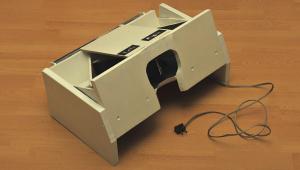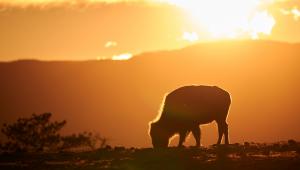Location Shoot: Studio Results; Portable Pro Lighting Tips & Gear Page 2
To enhance lighting further you should also consider light modifiers for your auxiliary flash. Just as in the studio, there are different types of light modifiers that can be used in the field, including reflectors and diffusers. Reflectors redirect the light while diffusers soften the light. Some commercially available modifiers include both reflective and softening components.
 |
|
|
Most commercial flash units have tiltable or rotatable heads, so adjusting
the head and bouncing the light off of a ceiling or even side wall helps soften
the light. In the early days of electronic flash photojournalists cut small
pieces of white cardboard and rubber banded them onto the head of the flash.
The flash would be pointed upward, tilting slightly forward. Most of the softened
light would bounce off of the card onto the subject.
In a room, some light would also bounce off of the ceiling, providing a secondary
light source that would fall behind the subject, reducing background shadows.
That technique worked very well, to the point that many newer flash units have
a retractable card built-in. Most of the built-in cards work OK in a pinch,
but they're too small for most creative work. The rule of thumb is: the
larger the reflector card, the softer the resulting light. With larger cards,
it's also possible to add a diffuser to soften the light even more.
While you can build your own light modifier, there's a nice selection
of units on the market. Commercial modifiers usually use touch fasteners. Placing
touch fasteners on three sides of the flash makes it possible to attach different
light modifiers for different applications. There are quite a few modifiers
available; here are some I have worked with:
The LumiQuest ProMax System includes the 80-20 Reflector that redirects 20 percent
of the light coming out of the flash directly onto the subject for very soft
fill light. The other 80 percent of the light passes through, to be redirected
by another surface, such as a ceiling. That provides an even, pleasing "two-light
look."
The ProMax System also includes the LumiQuest Bounce Kit, which redirects light
at a 90° angle from the flash to soften the shadows. It spreads the light
over a large area, for soft lighting with minimal shadows. To increase versatility
even further, the Bounce Kit comes with white, silver, and gold inserts that
modify the quality of the light so you can choose from silver specular highlights,
neutral tones, or a rich, warm light that simulates the late afternoon sun.
There's also a removable frosted diffusion screen to soften the light
even more. All the components come in a handy pouch. That's a complete
lighting system for $65.
 |
|
|
A very functional light modifier that I've found handy is the very lightweight
Hughes Soft Light Reflector. It's a simple single sheet of coated reflective
material that's cut so that when it's attached it forms a reflective
light cove. It can be "focused" so that most of the light falls
onto the subject, or opened up so that more light is available to reflect from
other surfaces. Priced at $39.95, it also works as a lens sunshade.
Another light modifier that can be attached to a flash is Gary Fong's
Lightsphere II Diffuser-Cloud. The Lightsphere is a cylindrical-shaped device
that evolved out of the Classic Portrait Dome, but with added translucent coloring
that slips over the flash head. Its shape and diffusion characteristics provide
overall soft light that envelops a subject, making it ideal for people photography.
The MSRP is $49.95.
Another light modifying option is a reflector that doesn't attach to the
flash. With their soft light, reflectors can add a professional look to photographs,
both in the studio and on location. Most photo reflectors are too large to carry
around on a regular basis. But there are some available that are small enough
to keep in a camera case. Photoflex, for example, has a set of lightweight 22"
LiteDiscs in various finishes that fold down to 9". The one I've
used for a number of years is the disc with the soft gold and white finish,
which is a good choice for close-up portraiture work. It costs $49.95.
Manufacturers/Distributors
Gary Fong, Inc.
228 Park Ave. South, Ste. 74641
New York, NY 10003
(800) 906-6447
www.garyfong.com
Jerry Hughes Photography, Inc. (Hughes Soft Light Reflector)
www.takegreatphotos.com
LumiQuest
28540 Durango Dr.
New Braunfels, TX 78132
(830) 438-4646
www.lumiquest.com
Photoflex
97 Hangar Way
Watsonville, CA 95076
(800) 486-2674
www.photoflex.com
- Log in or register to post comments

















































